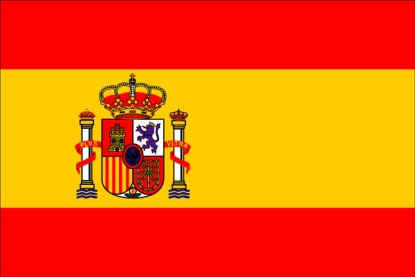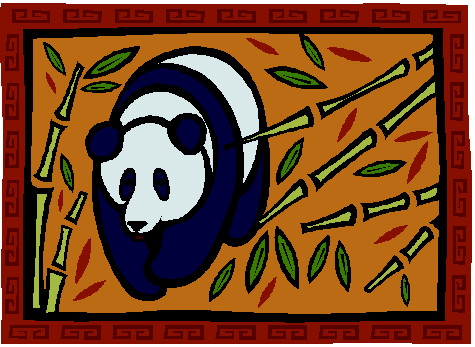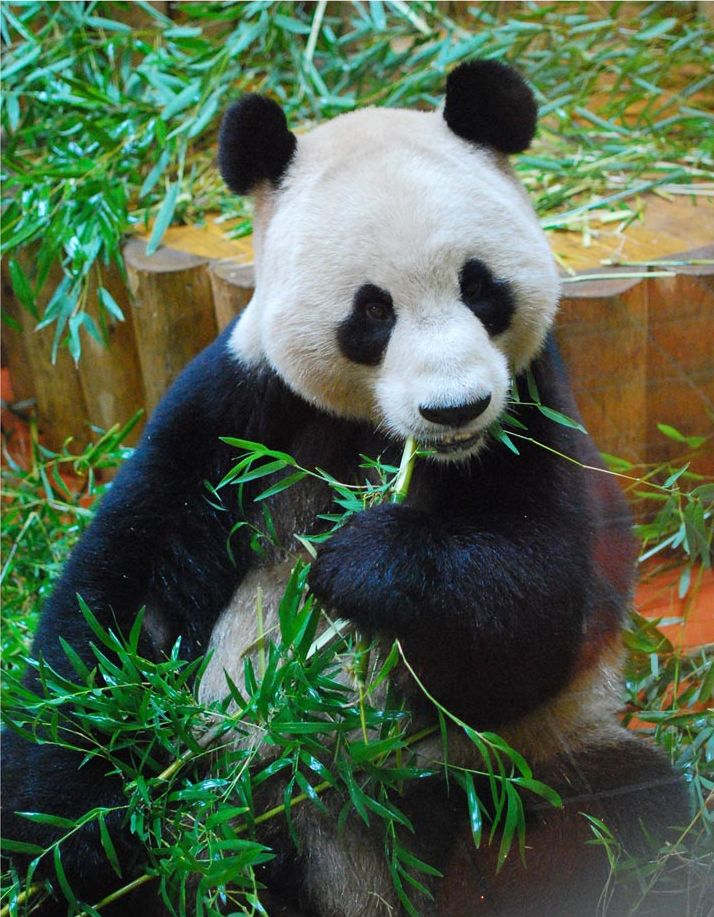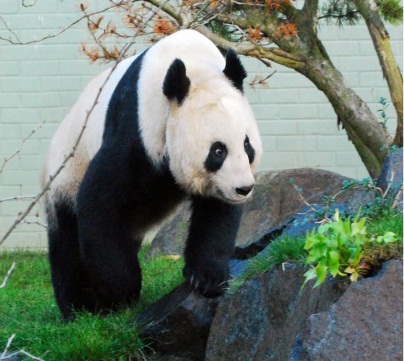Notes: Director of Animal Conservation and Research
 I am currently the Director of Giant Panda Project and Strategic Innovations at the Royal Zoological Society of Scotland. Between the ages of 9 and 12, I wanted to be a vet working in particular with large animals. I soon discovered that my perception of a vet’s work was very different from what I had imagined in that most vets work with small, domestic animals. However, I was lucky enough to have been brought up in Dundee, and from the age of 12, I did voluntary work in Camperdown Park. This practical experience became invaluable and I cannot recommend strongly enough that it is important to start young, especially these days when there is so much competition to gain places in courses such as Veterinary Medicine or Biological Sciences, which is what I studied at university.
I am currently the Director of Giant Panda Project and Strategic Innovations at the Royal Zoological Society of Scotland. Between the ages of 9 and 12, I wanted to be a vet working in particular with large animals. I soon discovered that my perception of a vet’s work was very different from what I had imagined in that most vets work with small, domestic animals. However, I was lucky enough to have been brought up in Dundee, and from the age of 12, I did voluntary work in Camperdown Park. This practical experience became invaluable and I cannot recommend strongly enough that it is important to start young, especially these days when there is so much competition to gain places in courses such as Veterinary Medicine or Biological Sciences, which is what I studied at university.
What role has language learning played in your career?
 It has become more and more important. I did French at school but was not particularly good at it. I cannot say I have a head for languages. However, I did live in South America and picked up Spanish. I found if I focused on conversations, I could pick up the gist of it. I would recommend reading newspapers, watching the news and keeping up to date with things. It is amazing how this improves your understanding.
It has become more and more important. I did French at school but was not particularly good at it. I cannot say I have a head for languages. However, I did live in South America and picked up Spanish. I found if I focused on conversations, I could pick up the gist of it. I would recommend reading newspapers, watching the news and keeping up to date with things. It is amazing how this improves your understanding.
What would you say is your underlying drive to continue learning languages?
My underlying passion is, of course, conservation. China has a very important role to play in this, as whatever happens in China will have a big impact on the rest of the world. You only have to look at the numbers. It has been predicted that at  some point in next few years there will be around 12 million Chinese tourists taking a holiday abroad, each month. Thus, China is on the move and their carbon footprint will increase greatly. Learning some Chinese, and above all, understanding their culture is most important to us. There is a big difference between our culture and the Chinese culture. The importance of Confucianism cannot be underestimated. Businessmen and others visiting China will fare much better if they are aware of this. For example, for Chinese people, there is no such thing as a “deal”. Their approach is to form a long term relationship. I sometimes go to China simply to see the people I have worked with, on an informal basis. Similarly, often important progress is made around the dinner table rather than at a board meeting. Dinner is not simply viewed as entertainment.
some point in next few years there will be around 12 million Chinese tourists taking a holiday abroad, each month. Thus, China is on the move and their carbon footprint will increase greatly. Learning some Chinese, and above all, understanding their culture is most important to us. There is a big difference between our culture and the Chinese culture. The importance of Confucianism cannot be underestimated. Businessmen and others visiting China will fare much better if they are aware of this. For example, for Chinese people, there is no such thing as a “deal”. Their approach is to form a long term relationship. I sometimes go to China simply to see the people I have worked with, on an informal basis. Similarly, often important progress is made around the dinner table rather than at a board meeting. Dinner is not simply viewed as entertainment.
What would you say about learning Chinese?

I would say, give yourself an advantage and learn Chinese. For example, Chinese tourists will need hotels and restaurants, and although many Chinese people speak some English, they love it when you can speak some of their language. Business cards are important in China. You should be aware of how to present your business card in China (with both hands), having it in both Chinese and English and choosing a Chinese name – Chinese friends can help you with this - all reflect respect for the Chinese way of doing things.

What tips would you give for anyone getting to grips with Chinese?
I would say, start by dipping into it. First of all, try and find out how the language is formed. It is very important to understand the story behind the character and how it evolved. Chinese language and culture are inseparable. That is what makes it so interesting. It also important to remember that there are various cultures and languages within China, just as there are here in the UK. It is not one big homogenised country..

What would you say has been the impact of the pandas arriving in 2012?
The arrival of the pandas is a great example of how appreciating the culture of another country is highly important. It took six years for us to secure the pandas, but the impact has been huge. Last year we had 810,000 visitors. The queue for the pandas never ceases.
Which part of China did the pandas come from?
When we first thought of trying to secure pandas, we understood it would be best to approach CWCA the China Wildlife Conservation Association which is part of the State Forestry Administration and looks after China Conservation and Research Centre for Giant Pandas (CCRCGP). They operate three centres for pandas in China: Bifengxia, Dujiangyan and Wolong, which are all based in Sichuan Province. The pandas came to Edinburgh Zoo through an agreement with CWCA and from the CCRCGP Bifengxia, centre.
Do you work closely with the research centres in China?

Yes, we do – and sometimes even informal links can have very important outcomes! For example, a British firm which produces MRI scanners has a factory close to the research centre in China. The company contacted Edinburgh zoo and asked about the possibility of doing an MRI scan on a panda, as machines were sitting there awaiting calibration. We approached our Chinese colleagues, who agreed, as little is known about certain aspects of Panda biology. This resulted in the brain of a male young panda being scanned. The scanner company has now got a unique marketing point and the Panda Research Centre is now considering investing in a scanner. This is a great example of how we can work collaboratively to help us all better understand a species. Of course, ultimately, our aim over time is to try and impress upon everyone how we should all help protect our environment and how each and every one of us has a role to play in doing this.
Do Chinese visitors come and visit the pandas here at the zoo?
 We get many Chinese visitors and that has been lovely. It’s also interesting to have some of our Chinese colleagues visit Scotland. They have enjoyed visiting New Lanark as they are interested in our own Industrial Revolution, David Owen and the social history of Scotland. Which brings me to another great example of a Scottish-China link: New Lanark is a World Heritage Site and is part of the Scottish 10 Project, which is a project run by a variety of Scottish partners including the Glasgow School of Art. The art school’s team in the Digital Design Studio is digitally mapping ten World Heritage Sites, including, in Scotland: St Kilda, Skara Brae, New Lanark and Rosslyn Chapel and in China, The Qing Ming tombs. This is a wonderful example of how new technology and science can be used to map important historical man made built structures and cultural artefacts and digitally preserve them, forever. China is very excited about this Scottish-led project.
We get many Chinese visitors and that has been lovely. It’s also interesting to have some of our Chinese colleagues visit Scotland. They have enjoyed visiting New Lanark as they are interested in our own Industrial Revolution, David Owen and the social history of Scotland. Which brings me to another great example of a Scottish-China link: New Lanark is a World Heritage Site and is part of the Scottish 10 Project, which is a project run by a variety of Scottish partners including the Glasgow School of Art. The art school’s team in the Digital Design Studio is digitally mapping ten World Heritage Sites, including, in Scotland: St Kilda, Skara Brae, New Lanark and Rosslyn Chapel and in China, The Qing Ming tombs. This is a wonderful example of how new technology and science can be used to map important historical man made built structures and cultural artefacts and digitally preserve them, forever. China is very excited about this Scottish-led project.
Return to Job Profiles